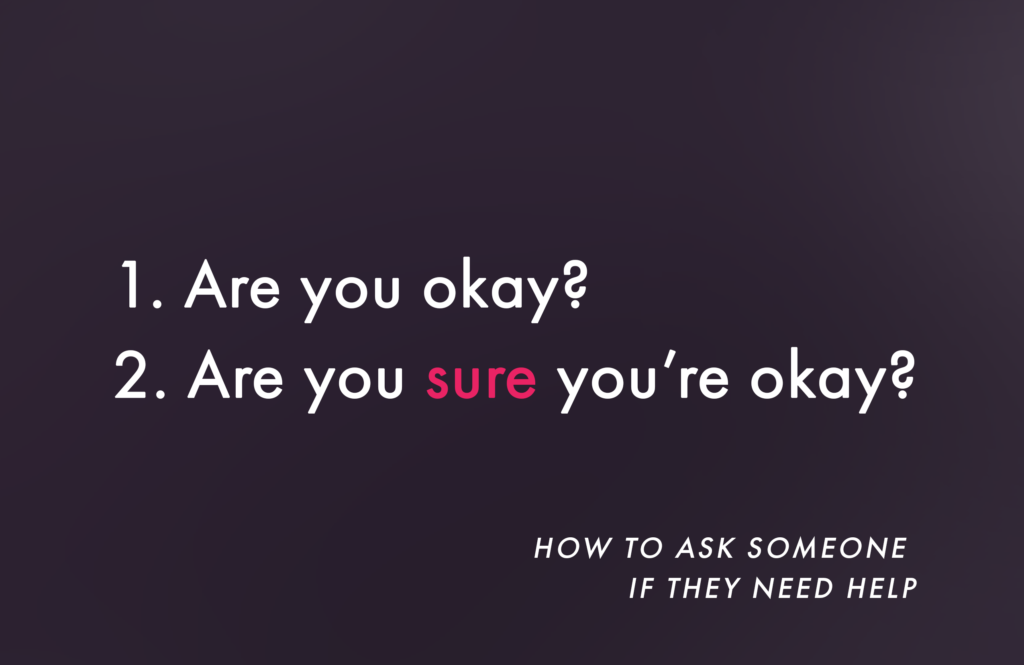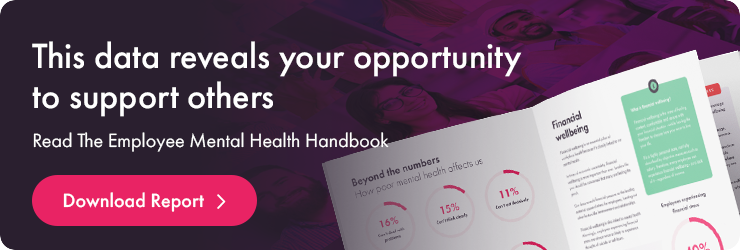We’re often asked: “Should I talk about mental health in a staff appraisal?”
It is every manager’s responsibility to support struggling employees and it’s often hard to find the right situation to talk about mental health.
But is an appraisal the right time to ask?
The answer depends on your leadership style and your organisation’s culture. Read on to find out if you’re ready to talk about mental health in a staff appraisal – and the best way to approach it.
Should you talk about mental health in a staff appraisal?
Getting people the right help when they need it has never been more important.
Our employee wellbeing statistics revealed that 60% of working professionals are experiencing mild symptoms of anxiety, 56% are experiencing symptoms of depression and 76% are experiencing moderate to high levels of stress.
With such widespread mental health challenges in the workplace, having open and honest conversations about mental health is essential.
And, by creating an environment where mental is not stigmatised, you’re more likely to spot the employees that are struggling with their mental health, so that they can be properly supported.
So, for organisations with a supportive culture, talking to your colleagues about mental health during a staff appraisal or 1:1 (one-to-one) can be invaluable.
“If it’s conducted in a compassionate, empathetic and natural way, it can be very powerful. Focus on the human and high performance will follow,” notes Harry Bliss, co-founder and CEO of Champion Health.
Staff appraisals have traditionally been shaped by performance reviews – but what is becoming clear now is that mental health is an essential pillar of high performance.
This means that any conversation about performance is also a conversation about mental health. So, during staff appraisals, take the opportunity to check in with an employee about how they’re doing.
Unfortunately, these conversations can be difficult to start and employees are often reluctant to open up to managers like you about struggles they may be having.
However, if you get it right, your appraisals and one-to-one meetings can become a valuable way to check in with the mental health of your employees.
First, consider your organisational culture
Before moving on to starting conversations around mental health, a quick word on organisational culture and the role it plays in allowing your employees to open up about how they are feeling.
“If 1:1s are the only time that mental health is mentioned, then they are the wrong time to mention it,” explains Jack Green, double Olympian and Head of Performance at Champion Health.
If you want to be proactive about your team’s wellbeing, mental health conversations can’t be limited to 1:1s or staff appraisals.
Instead, a culture should run throughout your organisation where employees feel able to open up about when they’re struggling, and trust that they’ll be listened to in an empathetic and understanding way.
If you’re not satisfied your organisation or team culture is ready to embrace discussing mental health in one-to-one meetings, read this guide to discover actionable ways you can promote a culture of mental health.
How to talk about mental health in a staff appraisal
Starting the mental health conversation can be daunting. Use these 10 tips and start an effective conversation about mental health during staff appraisals.
1. Ask open questions
Encouraging anyone to open up about mental health can be difficult – especially during work. So – how do you start the conversation?
Start by asking open questions, saying something like:
- “So, how have you been feeling lately?”
- “How are you doing?”
If you’re already concerned about your employee, you could ask questions like:
- “You’ve seemed a little quieter recently. What things can I do to help?”
- “I have noticed that you’ve not been your usual self lately. How are you feeling?”
- “Have you had any thoughts about how we could help you?”
And remember that these can’t just be cursory or tick-box questions. You must ask them with genuine curiosity and empathy.
You’re encouraged to ask regularly about mental health, even if you believe your colleague is okay. We all have mental health – even your most confident and outgoing colleagues may be suffering in silence.
2. Ask twice
Studies show that three in four of us say we’re okay even when we’re not. So, if you really want to find out how someone is doing, you must ask the question twice.
Simply asking again, with interest, will help your employee open up and this could lead to them disclosing an issue they otherwise would have kept hidden.
So, next time you ask, “How are you?”, follow it up with “How are you really doing?”
You might be surprised just how effective asking twice is.

3. Listen actively
Active listening is essential to strong communication, and it’s more than just hearing what another person has to say; it’s about trying to understand things from their point of view.
Not only will this help you fully immerse yourself in the conversation, it will also help to build rapport and make the other person feel validated, heard and more likely to open up.
The more you listen without interjecting your own thoughts or advice, the more you’ll understand and the better your communication will be.
It’s also important to stay objective as you listen and try not to judge or make any assumptions.
Make sure your colleague does not feel judged by saying things like:
- “That must have felt really…”
- “It’s okay to feel…”
- “That sounds like a normal reaction to a difficult situation”
4. Use reflective language
Reflective language is a useful tool to simultaneously show your support for your employee and encourage them to continue talking.
By using it well, you can keep the conversation flowing, giving your colleague ample time to open up about why they might be struggling.
Useful phrases to utilise include:
- “It sounds as if…”
- “It seems that…”
- “What I understand is that…”
- ‘‘So, it’s almost as if…”
5. Remember your body language
Non-verbal listening is essential to making sure that your employee feels heard and understood, so make sure you’re using it well.
Ensure that your entire demeanour is telling your employee that you are listening to what they’re saying, and that you want to hear more.
Ways of doing this include:
- Maintaining steady eye contact throughout the conversation
- Keeping your body language open, adopting a broader position with your shoulders back
- Being authentic – if you feel like you’re forcing your body language, your colleague will feel like that too
6. Consider who you’re communicating with
All effective communication depends on rapport, and you can create a huge amount of this without saying anything.
Consider the person you’re communicating with and meet them where they are.
For instance, if you’re speaking with someone who is quiet and shy, you might want to mirror their body language, match their level of eye contact and use small hand gestures or nods like theirs.
The opposite would be true for a louder or more confident communicator.
7. Emphasise confidentiality
We analysed a report asking the question: are remote mental health services effective?
It is clear from the report that a key concern for people using remote mental health services was confidentiality.
The same applies to in-person conversations, with employees often feeling apprehensive about disclosing any mental health issues.
Reduce these feelings by making it clear early in the conversation that anything they disclose will be kept as private as possible.
We all have mental health, and none of us should feel that speaking about it will harm our careers.
However, confidentiality has its limits, and when a person is at risk of harming themselves, the limits of confidentiality are reached.
If you believe this is the case, you should do everything you can to keep the employee safe, including informing a relevant person or calling 999.
This will ensure that your colleague will get access to timely and appropriate help.
8. Acknowledge your own support boundaries
If your employee tells you that they’re struggling, you don’t need to know all the answers or be able to “fix” the problem at hand.
Just being able to have an open, honest conversation about how someone is feeling is a great place to start.
So, don’t worry about giving medical advice – especially on areas that you’re not qualified to assist with.
You may feel that you can help by giving advice in a more general workplace sense, but you shouldn’t feel any pressure to even do this.
Instead, direct your energy into listening to your employee, supporting them and, if necessary, encouraging them to seek more qualified help. We cover signposting in more detail in point 10.
9. Utilise the CLASS Approach
Champion Health developed the CLASS Approach – a simple five-step process to help you support the mental health of others.
While this process is not specific for catch-ups or 1:1s, we recommend following it in these settings too.
You can utilise this approach before, during and after the conversation with your employees, to support them in the most effective way possible.
Discover how you can use the CLASS Approach for supporting others.
10. Know where to signpost
If your colleague needs further support, it’s essential to know where to signpost them on.
You’ve taken the difficult yet fantastic step of starting the conversation, but as you’re probably not a mental health professional, you’re not expected to be able to help the employee on your own.
There are many services you can signpost on to. A good place to start is your organisation’s internal wellbeing offering.
If you feel they need external help, then recommend local therapy services and national charities. We recommend:
Showing you care can go a long way
Leading a conversation about mental health can be daunting, but doing so effectively could be life-changing for one of your employees.
Remember, there’s no pressure to be ‘perfect’ in these conversations or know exactly how to respond. Staff 1:1s are a great chance to simply show your colleague that you care, you’re there for them and you want to help.
If you do that, then the rest will follow naturally.







